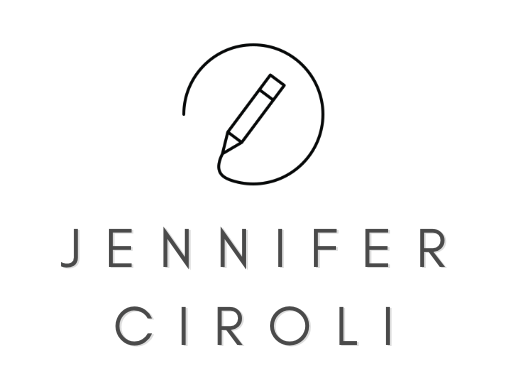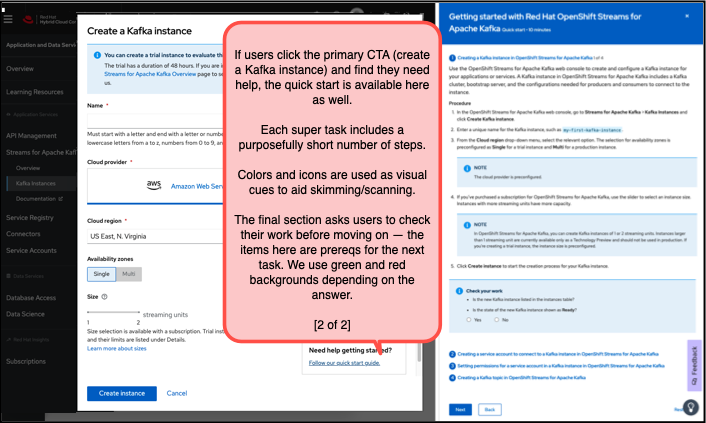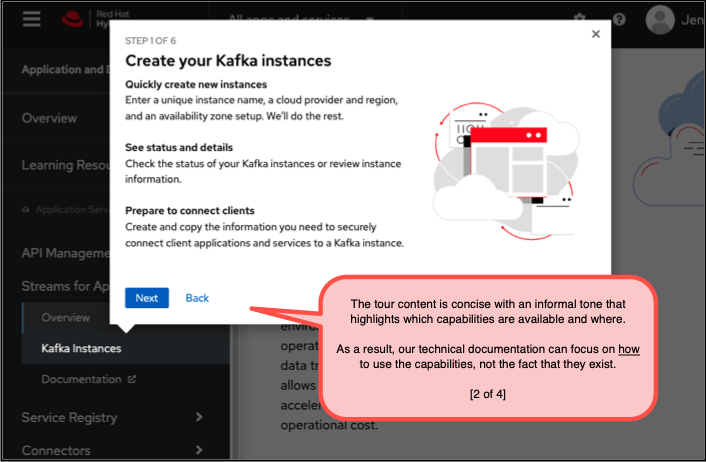I was hired as the first content strategist for our new cloud services. When I reflect, this was the perfect time to join; everyone — not just me! — was trying to figure out this exciting growth area, including what to do and how to do it.
Initially, I supported multiple programs and had lots of great opportunities to practice and expand my skills. Now, I work at the portfolio level across all services and on-prem products for Hybrid Cloud Experience (HCE). I love the chance to think more holistically about our content and lead/actively participate in high-impact strategy projects, and act as a go-to for other strategists, writers, and their managers.
I also participate in regular best practices and usability sessions and have presented twice.
Cloud services content types (lead presenter): Sharing what we’ve been doing with the entire content services organization to drive adoption and spur discussion
Building relationships (co-presenter): Examining why relationships build better user and content experiences and identifying how to establish those relationships
Note: We first gave this presentation at the 2020 UX Writers Conference, then adapted it to our specific Red Hat audience
My Role
Content strategy and plans
I developed the initial content strategy for our cloud application services and used it to create detailed content plans for individual services. At Red Hat, these content plans are a required part of any release. They:
Communicate the carefully planned and prioritized deliverables (plus any dependencies) to all stakeholders; an approved content plan is a requirement for each release.
Serve as a basis for writers who create the content.
Drive consistency in user and content experience across a quickly expanding portfolio.
I’m currently leading a collaborative effort to define a more cohesive and scalable content strategy for our ever-growing number of cloud services. While it incorporates much of the earlier strategy, it needs to be updated to reflect new initiatives and organizational priorities.
All strategy documents demand close collaboration with my writing team and lots of cross-functional stakeholders: Program managers, SMEs, engineers, UXD, marketing, and support.
Better cross-functional collaboration
I consider this area one of my biggest accomplishments; we are overcoming entrenched, outdated ways of working to really focus on — and improve — the user and content experience.
Together, the UXD team and I forged a new, essential partnership. Now, service strategists and writers are always part of creating UI and CLI content.
I adapted and co-presented the UX Writers Conference presentation to encourage and enable new or improved relationships with stakeholders.
I’m building new relationships and collaborations with all stakeholders who are excited by and/or contribute content for learning experiences and paths; this feeds nicely into our content type and content journey work (below). These new stakeholders come from the wider content services team, as well as the marketing, learning experience and design, and customer success and support teams. We’re all working on customer-facing content, and we shouldn’t be working on it in silos!
Content type definition and usage guidelines
I am passionate about providing the right content to the right users at the right time and place(s). To be successful, we need to think outside our existing mental models — what new kinds of content will help us modernize and achieve the “right content …” goal?
Last year, I partnered with UXD, engineering, and writers to advocate for and implement new content types. Together, we created a more seamless in-console experience with guided tours, interactive quick starts, contextual help, and more. What we created is still held up as the gold standard inside our organization.
Last year, I also started identifying, defining, and creating guidance for all of the existing and new content types we can use — many strategists, writers, and other stakeholders weren’t aware of the wide variety and didn’t know who should own them, who to collaborate with, and how to implement them. To help with this Herculean effort, I recruited a few other strategists.
This year, I’ve stepped back as the leader of this initiative to allow another strategist to grow her skills and influence. However, I’m still highly involved — we’re revisiting the initial work, defining a standard and more consumable way to present the information to all stakeholders.
UX writing
I’m always looking for more opportunities to practice and grow my skills in UX writing, as well as those of other strategists and writers. When writers work together with UXD, we can improve — and ensure consistency across — content that supports user experience and journeys. I’ve had several opportunities at Red Hat, including contributing to in-UI content.
Announcements
Microcopy (explanatory text, labels, empty states, messages, etc.)
Guided tours
Content journey standardization and adoption
Earlier this year, I was asked to own a key result (KR) for a higher organization-level OKR around the user and content experience for cloud services. Strategists need to begin creating content journeys that map to the larger user and customer journeys, which is a new paradigm for many.
As I collected and presented status each month for senior stakeholders, I noticed the other strategist had lots of confusion about (and inconsistencies within) the content journeys. I said to my manager, “I bet a content journey toolkit would reduce the confusion and inconsistencies while promoting adoption …”. She agreed, and now I’m leading the initiative. I’ve gathered a core set of enthusiastic participants to help:
Create a baseline of current practices/artifacts and all existing questions and concerns
Define what a content journey is and why it’s important — we need to establish common terminology and understanding across the whole organization
Determine the characteristics of a good content journey and the prerequisites needed to create one (e.g., personas, user journeys, use cases, etc.)
Identify — and create — the resources needed for the toolkit to be useful for strategists and writers (e.g., best practices, templates, checklists, etc.)
Socialize the toolkit within my team, the broader content services team, and cross-functional stakeholders
Documentation discovery and baseline
It’s been difficult to get a full picture of all the content we have for our 50+ HCE offerings. To mitigate this, the HCE doc program manager, a lead writer, and I are creating a baseline — what the content is, how it’s created, where it lives (source and published), and its structure, organization, and quality. From this, we can identify trends and spot both our strengths and opportunities to close gaps and improve.
Past and Current Projects
Project samples
Many things I work on are internal-only. The samples below represent public and/or non-confidential information.
Click any thumbnail to enlarge or open the associated PDF.
UX Writers Conference presentation
Strategy: Best Practices presentation (1 of 2)
Strategy: Best Practices presentation (2 of 2)
Strategy: Content types
Strategy: Interactive quick start exploration
Interactive quick start (1 of 2)
Interactive quick start (2 of 2)
Strategy + UX writing: Guided tour (1 of 4)
Strategy + UX writing: Guided tour (2 of 4)
Strategy + UX writing: Guided tour (3 of 4)
Strategy + UX writing: Guided tour (4 of 4)
UX writing: Retention (before)
UX writing: Retention (after)
UX writing: Partitions (before)
UX writing: Partitions (after)















